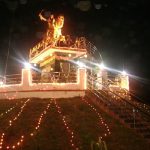KERALA VARMA PAZHASSI RAJA
A Malabar Prince and his Fight to the Finish with the British
Kerala, the strip of land beyond the Sahyadri, the Western Ghats, on the southwestern coastal belt of India, with its rivers, lakes and greenery, is renowned for its scenic splendour. Equally characteristic of the land is the deep-rooted democratic traditions of its people. So, the organized resistance to the British imperialism in the Malabar, Cochin and Travancore regions, which later constituted the modern-day state of Kerala, was always led by popular leaders drawing on the people’s power, rather than any sovereigns with their military as such. Thus, the resistance that the British met in Kerala was more in the form of rebellions than military campaigns; and by their very nature they became operationally unpredictable, and difficult to contain. The British, with their formidable military might, were often made to look foolish by these hot-blooded revolutionaries for nearly two decades; and only by 1809, a good ten years after they saw the last of Tipu Sultan, could they finally establish their supremacy over the entire stretch of Kerala.
The earliest of these rebellions was started off by the Kovilakam Rajas, members of the family of the Zamorin of Calicut, in resentment of the sovereign submitting to the British in 1792; but was easily put down by the British within the year. But much bigger trouble awaited them in the following year, as a conflict broke out at Kottayam under a popular prince turned rebel, Kerala Varma Pazhassi Raja, a descendant of the Kovilakam Rajas, who took up cudgels against the crude and unjust tax policy of the East India Company (This is the lesser-known ‘Kottayam’ in North Kerala, and not to be confused with the southern district with its capital town bearing the same name). So overwhelming was the people’s support to the prince that the company was forced to call off the tax collection for a year. Failing to break the impasse, the British attempted to seize the prince, who escaped to the mountains of Wayanad and launched a guerilla war. Gifted with exceptional flair for that kind of operation, and with thousands of volunteers rallying under him, he delivered such a humiliating defeat to the British in a 3-day engagement during March 1797, that they were forced to withdraw from Wayanad. Close on its heels, he ambushed a British contingent in the Peria Pass and virtually annihilated the 1100-man force. The British, finding it no more militarily or politically expedient to continue the fight, worked out a compromise formula and the two parties called a truce.
The uneasy peace lasted barely two years. After Tipu’s death, the British tried to take possession of Wayanad, ceded to them by the new Mysore ruler. Pazhassi Raja resisted the move, laying his own claim to the district. He raised a fairly big army and once again launched the guerilla campaign with renewed vigour. Arthur Wellesley, who then took command of the British operations, achieved a measure of success by improving the road network and restricting the Raja’s forces to the jungles, by putting up outposts at select points. Nevertheless, they struck back occasionally and after scoring a thumping victory by capturing the fort at Panamaram, went on to control the Wayanad passes. Seizing the opportunity of a popular uprising against the British on the issue of land assessments and table of exchange, they came out into the open again, defying the authorities.
The British had so far been employing Bombay troops in the region, and the 6000-man force they had, harassed as it was by the insurgency, was also being ravaged by malaria. They were replaced by Madras troops in 1804, who went onto blockade the Raja effectively in his jungle retreat. Finally, the Kolkar-s, a special police force raised by the authorities to counter insurgency, hunted him down, and shot him dead, on 30 November 1805.
In the end, it was once again the same old Indian story of rank betrayal. The Mir Jaffar in this episode was a man called Pazhayaveettil Chandu, a trusted dependent of the Raja. Chandu owed his very existence to the prince, having been taken care of and brought up by the latter from the time he was a young boy on the brink of starvation, with no one else to turn to. He chose to express his gratitude by secretly revealing the hideout of the Raja to the British, for whatever miserable consideration.
The British, on account of the popularity of the Raja, cremated him with honours befitting a ‘fallen enemy’. The revolt died with Pazhassi Raja, all his lieutenants being killed, deported, or committing suicide. Thus ended one of the bloodiest rebellions in the history of Kerala, which lasted over a decade, with thousands of lives lost on either side.
That Pazhassi Raja’s army was constituted of men from all classes and creeds of the society – Nairs, the traditional martial community, as well as the Kurichia tribals and Moplahs (Muslims) – was indicative of the amazing popularity he enjoyed among the masses. Thomas Harvey Baber, the Sub-Collector of Tellicherry, credited by the British for putting down the Pazhassi revolt, described the Raja as “an extraordinary and singular character”. He testified: “In all classes, I observed a decided interest in the Pychy Raja towards whom the inhabitants entertained a regard and respect bordering on veneration which not even his death can efface.”
The legend of Pazhassi Raja’s valiant resistance to colonialism still lives on in Kerala; but sadly, even by the 200th anniversary of it in the year 2005, the people of the state were yet to build a fitting memorial for this lionhearted prince who, unlike most of the royalty elsewhere in India, chose to fight to the very end, rather than meekly submit to the foreign dominance. The British had brutally given vent to their ire by razing his palace to the ground, and building a road over it. An interested historiographer can find Pazhassi Raja’s ancestral home, Patinjare Kovilakam, an ancient building in a state of disrepair, four kilometers outside the town of Mattannur in northern Kerala. In Mattannur itself, the Raja’s memory lingers on, with a statue, or an art gallery or some sports clubs named after him, and most prominently the Pazhassi Raja NSS College and a dam dedicated to his memory. In recent times, a Malayalam movie on the life of Pazhassi Raja, wherein superstar Mammooti donned the role of the prince, hit the screen. These and his tomb at Mananthawadi in the neighbourhood, with a small museum adjacent to it, are the only reminders of a great and gallant struggle, besides a small memorial stone on the bank of a rivulet, Mavila Thodu, off the river Kankara on the Kerala-Karnataka border – the spot at which he fell.





